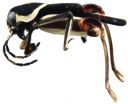(Press-News.org) VTT Technical Research Centre of Finland, the leading multi-technological applied research organisation in Northern Europe, has developed an optical accessory that turns an ordinary camera phone into a high-resolution microscope. The device is accurate to one hundredth of a millimetre. Among those who will benefit from the device are the printing industry, consumers, the security business, and even health care professionals. A new Finnish enterprise called KeepLoop Oy and VTT are already exploring the commercial potential of the invention. The first industrial applications and consumer models will be released in early 2012.
The operation of the device is based on images produced by the combined effect of an LED light and an optical lens. Various surfaces and structures can be examined in microscopic detail and the phone's camera used to take sharp, high-resolution images that can be forwarded as MMS messages.
An ordinary mobile phone turns into an instant microscope by attaching a thin, magnetic microscope module in front of the camera's normal lens. The device fits easily in the user's pocket, unlike conventional tubular microscopes.
The plastic macro lens of the mobile phone microscope magnifies objects effectively. The camera's field of view is 2 x 3 millimetres. A number of LEDs have been sunk into the outer edge of the lens, allowing objects to be illuminated from different angles. Images illuminated from several different angles could be used to produce 3D topographic maps, for example, with mobile phone software. The 3D maps would be accurate to one hundredth of a millimetre.
The competitive edge of the product is based on next-generation lens technology, the compact and user-friendly structure, and customisable extra features.
The mobile phone microscope is suited for examining surfaces and surroundings, for security, health care, and even games
The mobile phone microscope could also be used to study surface formations, especially in the printing industry as part of quality control and in field conditions. In the security business the device could be used, for example, to read microcode in various logistics systems, while it is also suited for studying security markings, and for authenticating products as genuine as part of brand protection. The microscope is capable of detecting hidden symbols in products that are not visible to the naked eye.
The device can also be applied to study of the environment. Consumers could use the instant microscope when out and about to examine the leaves of trees and plants, for example, or study insects. Another potential application is in examining textile structures such as strands of hair, or the fibrous structure of paper.
The device also has uses in social media, and in community-based hybrid media where traditional forms of media are used in combination with each other. There are also several potential applications in the gaming world.
###
Pictures: http://www.vtt.fi/news/2011/09032009.jsp
Further information:
VTT Technical Research Centre of Finland
Janne Suhonen
Key Account Manager
Tel. 358-20-722-2298
janne.suhonen@vtt.fi
KeepLoop Oy
Jaakko Raukola
Managing Director
Tel. 358-40-527-2684
jaakko.raukola@keeploop.com
Further information on VTT:
Olli Ernvall, Senior Vice President, Communications
Tel. 358-20-722-6747
olli.ernvall@vtt.fi
http://www.vtt.fi
VTT Technical Research Centre of Finland is a leading multitechnological applied research organization in Northern Europe. VTT creates new technology and science-based innovations in co-operation with domestic and foreign partners. VTT's turnover is EUR 290 million and its personnel totals 3,100.
KeepLoop Oy is a new innovative company based in Tampere, Finland. The company develops optoelectronic accessories for mobile telephones around the world. The company's target groups are both the industrial sector and consumers. By working together, VTT Technical Research Centre of Finland and KeepLoop have been able to produce a package that combines the scientific study of technology and commercial potential.
Finnish research organisation VTT combines mobile phone technology and microscopy
A pocket-size microscope accessory developed by Finnish scientists will be accurate to one hundredth of a millimeter
2012-02-16
ELSE PRESS RELEASES FROM THIS DATE:
Genetic mutation implicated in 'broken' heart
2012-02-16
BOSTON, MA (February 15, 2012) — For decades, researchers have sought a genetic explanation for idiopathic dilated cardiomyopathy (DCM), a weakening and enlargement of the heart that puts an estimated 1.6 million Americans at risk of heart failure each year. Because idiopathic DCM occurs as a familial disorder, researchers have long searched for genetic causes, but for most patients the etiology for their heart disease remained unknown.
Now, new work from the lab of Christine Seidman, a Howard Hughes Investigator and the Thomas W. Smith Professor of Medicine and Genetics ...
Improved emergency treatment for prolonged seizures
2012-02-16
When a person is experiencing a prolonged convulsive seizure, quick medical intervention is critical. With every passing minute, the seizure becomes harder to stop, and can place the patient at risk of brain damage and death. This is why paramedics are trained to administer anticonvulsive medications as soon as possible -- traditionally giving them intravenously before arriving at the hospital.
Now a major clinical trial has shown that an even faster method that involves injecting the drugs into the thigh muscle using an autoinjector (similar to a pre-loaded syringe) ...
Lava formations in western US linked to rip in giant slab of Earth
2012-02-16
Like a stream of air shooting out of an airplane's broken window to relieve cabin pressure, scientists at Scripps Institution of Oceanography at UC San Diego say lava formations in eastern Oregon are the result of an outpouring of magma forced out of a breach in a massive slab of Earth. Their new mechanism explaining how such a large volume of magma was generated is published in the Feb. 16 issue of the journal Nature.
For years scientists who study the processes underlying the planet's shifting tectonic plates and how they shape the planet have debated the origins of ...
Black hole came from a shredded galaxy
2012-02-16
Astronomers using NASA's Hubble Space Telescope have found a cluster of young, blue stars encircling the first intermediate-mass black hole ever discovered. The presence of the star cluster suggests that the black hole was once at the core of a now-disintegrated dwarf galaxy. The discovery of the black hole and the star cluster has important implications for understanding the evolution of supermassive black holes and galaxies.
"For the first time, we have evidence on the environment, and thus the origin, of this middle-weight black hole," said Mathieu Servillat, who worked ...
Plasmas torn apart
2012-02-16
VIDEO:
An argon plasma jet forms a rapidly growing corkscrew, known as a kink instability. This instability causes an even faster-developing behavior called a Rayleigh-Taylor instability, in which ripples grow and...
Click here for more information.
PASADENA, Calif.—January saw the biggest solar storm since 2005, generating some of the most dazzling northern lights in recent memory.
The source of that storm—and others like it—was the sun's magnetic field, described by ...
Tool assessing how community health centers deliver 'medical home' care may be flawed
2012-02-16
On the health front, the poor often have at least two things going against them: a lack of insurance and chronic illnesses, of which diabetes is among the most common.
The federal Affordable Care Act would expand the capacity of the nation's 8,000 community health centers to provide care for low-income, largely minority patients — from the current 20 million to about 40 million by 2015. The federal government is also trying to ensure that these community health centers deliver high-quality primary care, including diabetes care.
A crucial part of this is the implementation ...
Astronomers watch delayed broadcast of a rare celestial eruption
2012-02-16
Pasadena, CA— Eta Carinae, one of the most massive stars in our Milky Way galaxy, unexpectedly increased in brightness in the 19th century. For ten years in the mid-1800s it was the second-brightest star in the sky. (Now it is not even in the top 100.) The increase in luminosity was so great that it earned the rare title of Great Eruption. New research from a team including Carnegie's Jose Prieto, now at Princeton University, has used a "light echo" technique to demonstrate that this eruption was much different than previously thought. Their work is published Feb. 16 in ...
Contraceptive preferences among young Latinos related to sexual decision-making
2012-02-16
CORVALLIS, Ore. – Half of the young adult Latino men and women responding to a survey in rural Oregon acknowledge not using regular effective contraception – despite expressing a desire to avoid pregnancy, according to a new Oregon State University study.
Researchers say the low rate of contraception among sexually active 18- to 25-year-olds needs to be addressed – and not just among Latino populations. Research has shown many young adults from all backgrounds eschew contraception for many reasons including the mistaken belief that they or their partners cannot get pregnant.
"The ...
Complexities in caregiving at the end of life
2012-02-16
Faced with the inevitability of death, we all wish for good caregiving during the final stage of our lives. A new study from Karolinska Institutet and Umeå University shows that non-pharmacological caregiving at the end of life in specialized palliative care is not as basic as one might believe but is based on complex professional decisions that weave physical, psychosocial and existential dimensions into a functional whole. The researchers have found that particularly important aspects of palliative care are an aesthetically pleasing, safe and comfortable environment, ...
New miniature grasshopper-like insect is first member of its family from Belize
2012-02-16
Scientists at the University of Illinois, USA have discovered a new species of tiny, grasshopper-like insect in the tropical rainforests of the Toledo District in southern Belize. Dr Sam Heads and Dr Steve Taylor co-authored a paper, published in the open access journal ZooKeys, documenting the discovery and naming the new species Ripipteryx mopana. The name commemorates the Mopan people – a Mayan group, native to the region.
"Belize is famous for its biodiversity, although very little is known about the insect fauna of the southern part of the country. This is particularly ...
LAST 30 PRESS RELEASES:
Jeonbuk National University study shows positive parenting can protect adolescents against self-harm
Surface-engineered ZnO nanocrystals to tackle perfluoroalkyl substance contamination
This new understanding of T cell receptors may improve cancer immunotherapies
A new fossil face sheds light on early migrations of ancient human ancestor
A new immunotherapy approach could work for many types of cancer
A new way to diagnose deadly lung infections and save lives
40 percent of MRI signals do not correspond to actual brain activity
How brain-inspired algorithms could drive down AI energy costs
Gum disease may be linked to plaque buildup in arteries, higher risk of major CVD events
Contrails are a major driver of aviation’s climate impact
Structure of dopamine-releasing neurons relates to the type of circuits they form for smell-processing
Reducing social isolation protects the brain in later life
Keeping the heart healthy increases longevity even after cancer
Young adults commonly mix cannabis with nicotine and tobacco
Comprehensive review illuminates tau protein's dual nature in brain health, disease, and emerging psychiatric connections
Book prepares K-12 leaders for the next public health crisis
Storms in the Southern Ocean mitigates global warming
Seals on the move: Research reveals key data for offshore development and international ecology
Sports injuries sustained during your period might be more severe
World's first successful 2 Tbit/s free-space optical communication using small optical terminals mountable on satellites and HAPS
Can intimate relationships affect your heart? New study says ‘yes’
Scalable and healable gradient textiles for multi‑scenario radiative cooling via bicomponent blow spinning
Research shows informed traders never let a good climate crisis go to waste
Intelligent XGBoost framework enhances asphalt pavement skid resistance assessment
Dual-function biomaterials for postoperative osteosarcoma: Tumor suppression and bone regeneration
New framework reveals where transport emissions concentrate in Singapore
NTP-enhanced lattice oxygen activation in Ce-Co catalysts for low-temperature soot combustion
Synergistic interface engineering in Cu-Zn-Ce catalysts for efficient CO2 hydrogenation to methanol
COVID-19 leaves a lasting mark on the human brain
Scientists use ultrasound to soften and treat cancer tumors without damaging healthy tissue
[Press-News.org] Finnish research organisation VTT combines mobile phone technology and microscopyA pocket-size microscope accessory developed by Finnish scientists will be accurate to one hundredth of a millimeter



